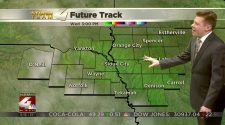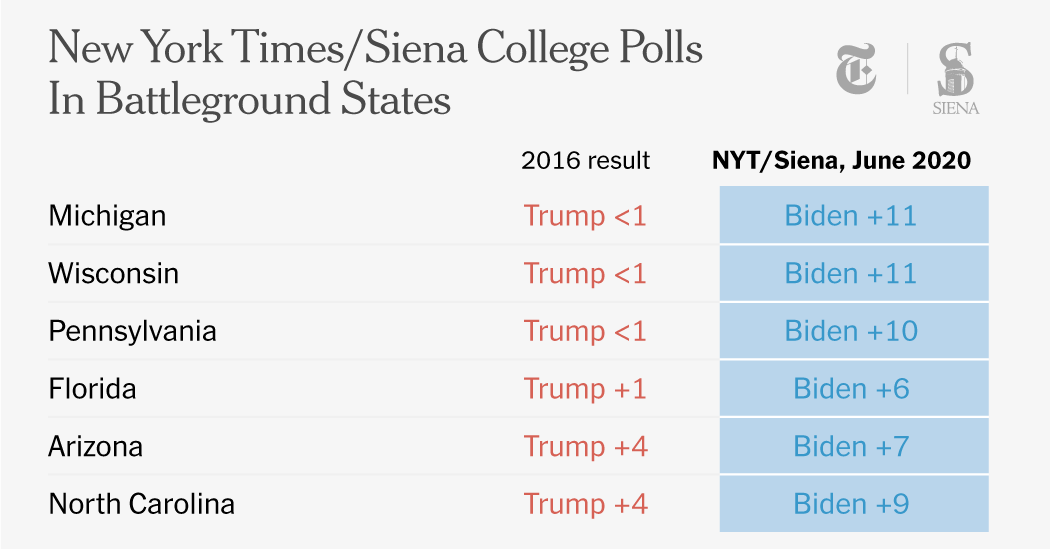President Trump has lost significant ground in the six battleground states that clinched his Electoral College victory in 2016, according to New York Times/Siena College surveys, with Joseph R. Biden Jr. opening double-digit leads in Michigan, Pennsylvania and Wisconsin.
Mr. Trump’s once-commanding advantage among white voters has nearly vanished, a development that would all but preclude the president’s re-election if it persists. Mr. Biden now has a 21-point lead among white college graduates, and the president is losing among white voters in the three Northern battleground states — not by much, but he won them by nearly 10 points in 2016.
Four years ago, Mr. Trump’s strength in the disproportionately white working-class battleground states allowed him to win the Electoral College while losing the popular vote. The surveys indicate that the president continues to fare better in these relatively white battleground states than he does nationwide.
A separate Times/Siena survey released on Wednesday found Mr. Biden leading by 14 points nationwide, 50 percent to 36 percent.
Mr. Biden would win the presidency with at least 333 electoral votes, far more than the 270 needed, if he won all six of the states surveyed and held those won by Hillary Clinton four years ago. Most combinations of any three of the six states — which also include Florida, Arizona and North Carolina — would suffice.
With a little more than four months to go until the election, there is still time for the president’s political standing to recover, just as it did on so many occasions four years ago. He maintains a substantial advantage on the economy, which could become an even more central issue in what has already been a volatile election cycle. And many of the undecided voters in these states lean Republican, and may end up returning to their party’s nominee.
But for now, the findings confirm that the president’s political standing has deteriorated sharply since October, when Times/Siena polls found Mr. Biden ahead by just two percentage points across the same six states (the gap is now nine points). Since then, the nation has faced a series of crises that would pose a grave political challenge to any president seeking re-election. The polls suggest that battleground-state voters believe the president has struggled to meet the moment.
Over all, 42 percent of voters in the battleground states approve of how Mr. Trump is handling his job as president, while 54 percent disapprove.
These six states — with their mix of major cities, old industrial hubs, growing suburbs, and even farmland — together deliver a grim judgment of Mr. Trump on recent issues that have shaken American life. His handling of the pandemic and the protests after the death of George Floyd help explain his erosion across both old and new battlegrounds.
On these issues, voter disapproval reflects more than just general dissatisfaction with the state of the country. It seems to reflect deeper disagreement with the president’s prioritization of the economy and law and order over the coronavirus pandemic and criminal justice.
A majority of voters, 63 percent, say they would rather back a presidential candidate who focuses on the cause of protests, even when the protests go too far, while just 31 percent say they would prefer to support a candidate who says we need to be tough on demonstrations that go too far.
Despite double-digit unemployment, 55 percent of voters in these six states say the federal government’s priority should be to limit the spread of the coronavirus, even if it hurts the economy, while just 35 percent say the federal government’s priority should be to restart the economy. Even the newly unemployed, who would seem to have the most to gain from a reopened economy, say stopping the coronavirus should be the government’s priority.
As of now, 59 percent of voters in Michigan disapprove of Mr. Trump’s handling of the coronavirus, the highest level of disapproval in any battleground state polled. And nearly 40 percent of registered voters there, including 11 percent of Republicans, say he has treated their state worse than others in response to the pandemic.
Mr. Trump’s ratings are healthier on the kinds of issues that might have dominated the election season under more ordinary circumstances. His 56 percent approval rating on the economy, versus 40 percent who disapprove, is nearly the opposite of his overall job approval rating. Battleground voters say by a double-digit margin that he would do a better job on the issue than Mr. Biden, and they also prefer Mr. Trump to handle relations with China.
With a little more than four months to go until the election, there is still time for memories to fade or for the national debate to return to more favorable turf for the president. But these are not ordinary circumstances, and for now the president’s coalition has suffered serious defections, eroding the familiar demographic divides of recent elections.
Mr. Trump retains the support of 86 percent of respondents who said they voted for him in 2016, down from 92 percent in October.
Mr. Biden, by contrast, has emerged from a contested primary with a unified Democratic coalition. He wins 93 percent of the voters who backed Mrs. Clinton four years ago, as well as 92 percent of self-identified Democrats. Mr. Biden also enjoys a significant advantage among those who voted for neither Mr. Trump nor Mrs. Clinton in 2016. He has a 35-point lead among battleground voters who said they backed a minor-party candidate or wrote in another.
Together, these shifts give Mr. Biden a six-point lead among voters who participated in the 2016 election, according to voter-file records. The same voters said they backed Mr. Trump over Mrs. Clinton in 2016 by 2.5 percentage points, slightly better for Mr. Trump than the actual result of the six states, offering a level of validity to the survey’s findings. Mr. Biden also has a 17-point lead among registered voters who did not vote in the 2016 race.
Mr. Trump’s once-decisive advantage among white voters has all but vanished, despite national attention to the kind of racial issues that many analysts believed propelled his strength among white voters in the first place. If attitudes about race were vital to Mr. Trump’s appeal with white voters, then a foundation of his strength has been badly shaken.
Mr. Biden’s gains among white voters have been largest among the young and college-educated white voters likeliest to back the protesters’ views on racial issues.
Over all in the six states, Mr. Biden holds a 55-34 lead among white voters with at least a four-year college degree, an 11-point gain from October. White voters under age 35 now back Mr. Biden by a margin of 50 percent to 31 percent, up from an all-but-tied race in October.
White voters with more conservative attitudes on racial issues appear to have soured on Mr. Trump in recent months, and yet they have not embraced Mr. Biden.
White voters without a degree, the linchpin of the president’s winning coalition, back Mr. Trump by a 16-point margin in the battlegrounds, down from a 24-point margin in October and a 26-point one in the final polls of the last election. Despite that slide, Mr. Biden’s support among white voters without a degree has increased by only one percentage point since October.
Mr. Biden leads among voters 65 and over, reversing a decade-long Republican advantage. But he has made relatively limited gains among voters over age 50 since October, including no gains at all among white voters over age 50 without a college degree.
Their relatively conservative attitudes on race and the protests could be part of the reason for the president’s resilience: White voters in the battleground states who are 50 and over oppose the recent demonstrations, and say too many have turned to violent rioting. They are split on whether discrimination against whites is as big a problem as discrimination against minorities, and say that riots are a bigger problem than police treatment of African-Americans by a 10-percentage-point margin.
Perhaps more surprisingly, Mr. Biden has also made few to no gains among nonwhite voters, despite the national attention on criminal justice and racism over the last month.
Over all in the battlegrounds, Mr. Biden leads among black voters by 83 percent to 7 percent, up only slightly from October. Hispanic voters back Mr. Biden by 62-26, also essentially unchanged. Neither lead exceeds Mrs. Clinton’s margin in the final polls from 2016.
Mr. Biden’s wide lead is a reflection of the president’s weakness rather than of his own strength. Over all, 55 percent of Mr. Biden’s supporters say their vote is more a vote against Mr. Trump than a vote for Mr. Biden, while 80 percent of Mr. Trump’s supporters say they’re mainly voting for the president. And Mr. Biden’s gains have come without any improvement in his favorability ratings, even as Mr. Trump’s have plummeted.
But Mr. Biden’s standing is nonetheless healthy by most measures. Over all, 50 percent of battleground voters say they have a favorable view of him, compared with 47 percent who have an unfavorable view.
It’s possible that Mr. Biden will struggle to match his wide lead in the polls at the ballot box. The battleground voters who don’t back either Mr. Biden or Mr. Trump tend to tilt Republican, whether by party registration or by affiliation, and 34 percent say they voted for Mr. Trump in 2016, compared with 20 percent who backed Mrs. Clinton.
Some of these voters may return to the president by the end of the race, yet at the moment, 56 percent of these voters disapprove of his performance, while just 29 percent approve.
The results suggest that Mr. Biden still has an open path to a sweeping victory. Over all, 55 percent of registered voters in the battleground states said there was at least “some chance” they would support Mr. Biden in the election, including 12 percent of Republicans, 11 percent of voters who backed Mr. Trump in 2016, and 44 percent of the Republican-tilting undecided voters.
As for Mr. Trump, 55 percent of registered voters in the battlegrounds said there was “not really any chance” they would vote for him this November.
The Times/Siena poll of 3,870 registered voters in Pennsylvania, Michigan, Florida, Arizona, Wisconsin and North Carolina was conducted from June 8 to 18. The margin of sampling error for an individual state poll ranges from plus-or-minus 4.1 to 4.6 percentage points. The margin of sampling error on the full battleground sample is plus-or-minus 1.8 percentage points.
Here are the crosstabs and methodology for the poll.


















